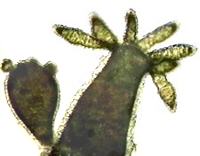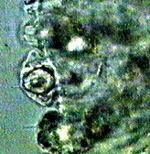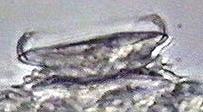HYDRA
by Mike Morgan 1996
Overview
A widely distributed genus of solitary freshwater invertebrate animals belonging to an
order (Hydroidea) within the phylum Coelenterata. They are flexible polyps, 10-30 mm long,
with the mouth at the top surrounded by up to 10 tentacles.
The New Latin name, Hydra, is derived from the monster in Greek legend with many heads who grew two more whenever one was cut off. It was finally slain by Hercules who cauterised each neck after severing its head. The regenerative powers of hydra are quite remarkable, a single hydra may be cut into many pieces and provided that each piece contains a portion of the two body layers, ectoderm and endoderm, it will develop into a complete animal. A Hydra was first described by Leeuwenhoek in 1703.
Hydra with Bud

Various species occur in ponds and slow-flowing rivers. The species normally studied is the green hydra, Chlorohydra viridissima. Brown, orange and colourless Hydrae also occur and all have the same general structure. The green colour of Chlorohydra viridissima is due to the presence of small alga of the genus Chlorella which live within the body of the hydra. This is a symbiotic relationship in which the algae make use of those substances that the hydra would normally excrete, such as carbon dioxide, phosphates and nitrogenous substances. For its part, hydra benefits by receiving the oxygen produced by photosynthesis. If there is a food shortage, hydra will digest the plant cells and later ingest more living algae which it does not digest.
 Hydra can be found attached to water-plants, stones etc., with
its cylindrical body hanging downwards, with the tentacles gently moving. When disturbed
it will rapidly contract into a blob of jelly, making it difficult to find. Hydrae feed on
small animals, such as water-fleas. These are caught by structures called nematocysts.
There are different types of nematocysts, some stinging and paralysing the prey, whilst
others discharge threads which coil round the prey and hold it.
Hydra can be found attached to water-plants, stones etc., with
its cylindrical body hanging downwards, with the tentacles gently moving. When disturbed
it will rapidly contract into a blob of jelly, making it difficult to find. Hydrae feed on
small animals, such as water-fleas. These are caught by structures called nematocysts.
There are different types of nematocysts, some stinging and paralysing the prey, whilst
others discharge threads which coil round the prey and hold it.
Nematocysts arise from cells known as nematoblasts. It is interesting that no other phylum produce these cells, however, they are sometimes found in the epidermis of free-living flat-worms. The flat-worms eat the hydra but do not digest the nematoblasts, which end up in the epidermis and form a defensive mechanism for the flat-worm. This is a very unusual case of a natural implantation of cells from one animal into another. Pictured above right is a high power view of part of the tentacle, showing the position of the nematocysts.
 By gently pressing on the coverslip, it is possible to squash a
portion of the tentacle and so cause the nematocyst to discharge. Pictured left, is such a
discharged nematocyst. Note the barbs.
By gently pressing on the coverslip, it is possible to squash a
portion of the tentacle and so cause the nematocyst to discharge. Pictured left, is such a
discharged nematocyst. Note the barbs.
Hydra reproduce both asexually and sexually. Asexual reproduction takes place in the winter in the process known as budding (see picture above). Sexual reproduction occurs in the summer, though the brown hydra (H. fusca) prefers the autumn months.
 Scurrying over the body surface of hydra may be seen a number of
small animals. These remove bacteria and other debris. These animals are referred to as
'commensals' and do no harm to the hydra. Trichodina is one such animal and is
shown on the right in a high power view.
Scurrying over the body surface of hydra may be seen a number of
small animals. These remove bacteria and other debris. These animals are referred to as
'commensals' and do no harm to the hydra. Trichodina is one such animal and is
shown on the right in a high power view.
Editor's note: For other Micscape resources on hydra including video clips and 3D images, please visit the Micscape Library - Pond life/hydra section.
Microscopy UK Front Page
Micscape Magazine
Article Library
© Microscopy UK or their contributors.
Please report any Web problems or
offer general comments to the Micscape Editor,
via the contact on current Micscape Index.
Micscape is the on-line monthly
magazine of the Microscopy UK web
site at Microscopy-UK
